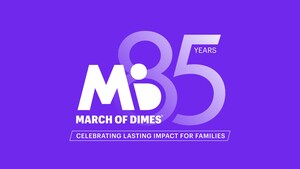The Microbiome Of A Woman's Reproductive Tract May Predict Preterm Birth
March of Dimes Prematurity Research Center at Stanford Identifies Differences Early in Pregnancy
WHITE PLAINS, N.Y., Aug. 17, 2015 /PRNewswire-USNewswire/ -- The microbiomes in the reproductive tracts of pregnant women who later had a baby born too soon are significantly different from those of women who delivered full term.
The microbiome, a community of microorganisms on and in the body, is an emerging area of research that may help explain health issues as different as preterm birth, asthma and inflammatory bowel disease.
Researchers at the March of Dimes Prematurity Research Center at Stanford University took weekly samples of the microorganisms from the teeth and gums, saliva, reproductive tract, and stool from 49 pregnant women. They found little change in the bacterial communities in each woman, week to week at each location. But they did find that microbial communities in the reproductive tracts of women who delivered their babies too soon were different from those of women who delivered full term. Those differences were found early in the pregnancies and tended to persist throughout the pregnancies.
"These findings may help us screen women and identify and predict those who are more likely to have a baby born too soon," said David Relman, MD, a professor of microbiology, immunology, and of medicine at the Stanford University School of Medicine and the lead investigator for the research center on this project.
Preterm birth is the number one killer of newborns and serious gaps exist between racial and ethnic groups. More than 450,000 babies are born too soon in the U.S. and the national preterm birth rate is worse than that of most other high-resource countries, the March of Dimes says. Worldwide, 15 million babies are born preterm, and more than one million die due to complications of an early birth. Babies who survive an early birth face serious and lifelong health problems, including breathing problems, jaundice, vision loss, cerebral palsy and intellectual delays.
The research paper "Temporal and Spatial Variation of the Human Microbiota During Pregnancy" was published Aug. 17 in the journal, Proceedings of the National Academy of Sciences. The researchers also found that the patterns of women's microbiomes changed immediately after they delivered their babies, and did not revert back to pre-pregnancy patterns in some cases until at least a year later.
"This might explain why women with closely spaced pregnancies have a higher risk of preterm birth," said Dr. Relman.
The March of Dimes is raising $75 million to support its five prematurity research centers. These unique, transdisciplinary centers bring together the brightest minds from many diverse disciplines -- geneticists, molecular biologists, epidemiologists, engineers, computer scientists, and others -- to work together to find answers to prevent premature birth. In addition to the research center at Stanford in California, the March of Dimes established a research center with a group of universities and hospitals in Ohio, and centers at the University of Pennsylvania, at Washington University in St. Louis, and at the University of Chicago, Northwestern University and Duke University.
"Our nationwide network of prematurity research centers is critical to understanding the unknown causes of preterm birth. This new finding puts in place another piece toward solving the much larger puzzle of preterm birth," says Dr. Jennifer L. Howse, President of the March of Dimes.
The March of Dimes works to improve the health of babies by preventing birth defects, premature birth and infant mortality. The March of Dimes is the leading nonprofit organization for pregnancy and baby health. For the latest resources and information, visit marchofdimes.org or nacersano.org. Visit prematurityresearch.org for more information about the research centers. Find us on Facebook and Twitter.
Logo - http://photos.prnewswire.com/prnh/20150409/197662LOGO
SOURCE March of Dimes
Related Links
WANT YOUR COMPANY'S NEWS FEATURED ON PRNEWSWIRE.COM?
Newsrooms &
Influencers
Digital Media
Outlets
Journalists
Opted In





Share this article